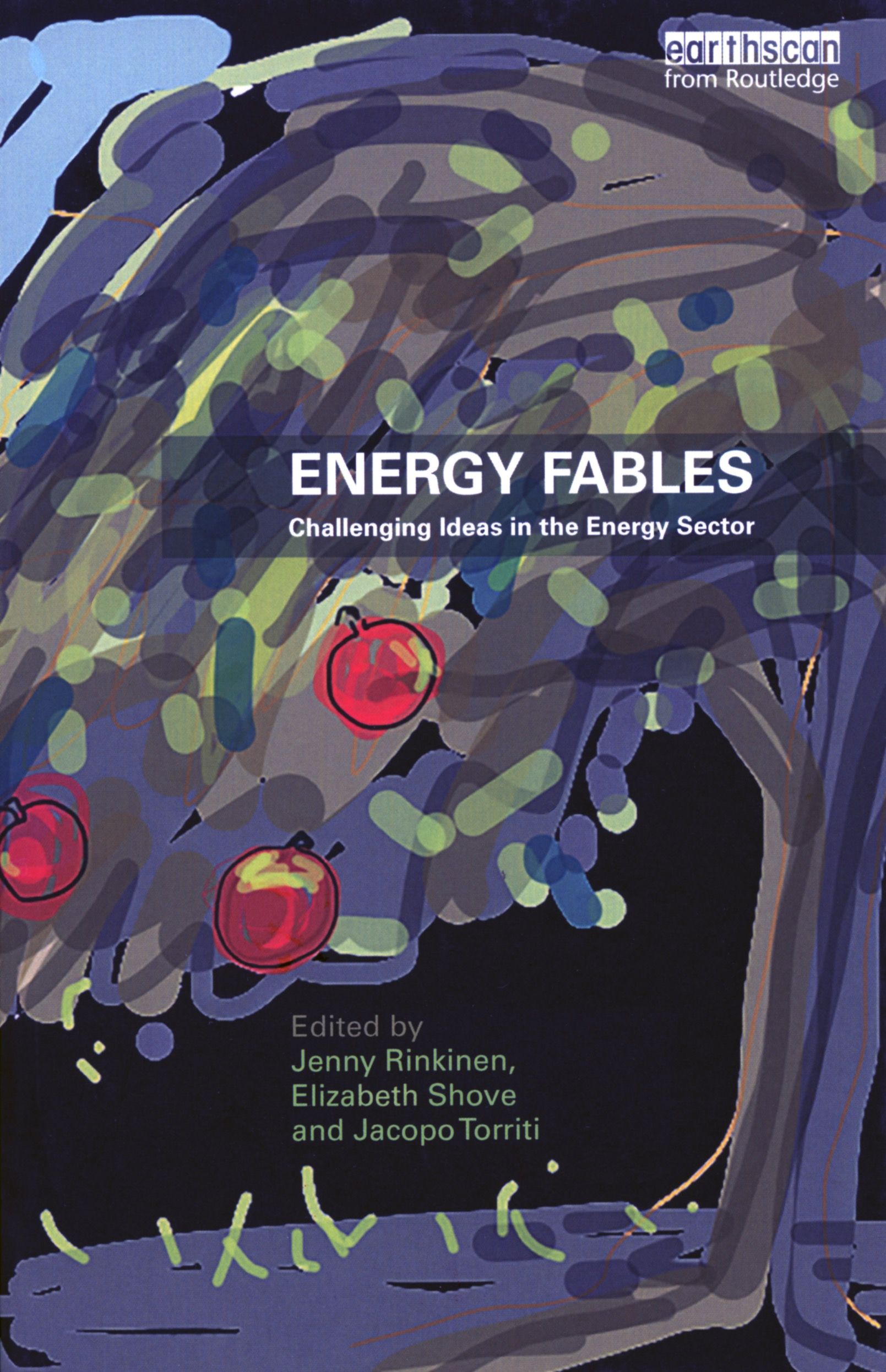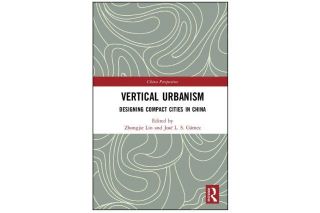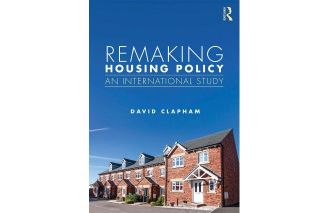
www.buildingsandcities.org/insights/reviews/energy-fables-challenging-ideas-energy-sector.html
Energy Fables: Challenging Ideas in the Energy Sector
Edited by Jenny Rinkinen, Elizabeth Shove, and Jacopo Torriti. Routledge, 2019, ISBN: 9780367027797.
 Mithra Moezzi (QQForward) applauds this short,
powerful book for revealing how many current energy discourses are framed
and their limitations. The authors provide constructive, inspiring
approaches that will help us to better understand and reframe energy practices,
research and policies.
Mithra Moezzi (QQForward) applauds this short,
powerful book for revealing how many current energy discourses are framed
and their limitations. The authors provide constructive, inspiring
approaches that will help us to better understand and reframe energy practices,
research and policies.
Energy Fables sees the energy efficiency profession as being guided by a constellation of shared concepts, words, and short stories "worn smooth through use and submerged within familiar discourses in government, and well as in research and teaching" (p. 1). These are building blocks of communication, problem definition, and solutions in the field, creating "fables" that "sustain and reproduce a body of ideas about what is normal and about what drives change" (p. 124). As the problems addressed by the profession continue to expand from achieving energy efficiency as defined in the past to the much larger scale and ambitions of climate change policy, the authors argue, limitations of these traditional concepts have become clearer and more consequential.
Eleven example fables are taken on in this edited volume. Each gets its own chapter, none longer than ten pages. The chapters are readable separately versus a full read of the book. The collection begins with how fundamentals (energy demand, energy efficiency, and energy services) are defined and deployed. It then turns to ideas about energy dynamics (rebound, elasticity) and to common "injunctions" ("keep the lights on," "pick the low hanging-fruit," and promote Smart Homes) and finally to broad policy themes (the energy trilemma, flexibility, and focus on energy versus non-energy policy as the main vehicle for influencing change). An introduction and postscript bracket the fable chapters. As seen in a traditional concept of folklore, these fables reinforce existing culture while also serving as devices for debate.
Each fable is analyzed to reveal aspects of the worldview it reflects and as to how it directs policy and research. From there, the authors challenge the fable and directions it carries regarding energy problems, and then suggest the beginnings of new approaches and perspectives that edge past current limitations to better serve climate change policy. For example, the term "rebound" brings with it the idea of bouncing off a hypothetical hard world where a new technology would have no impact on the energy services demanded, with a bounce-back representing recovery of part of the value of this efficiency via increased levels of energy services (p. 40). Despite research attention to nailing down estimates of rebound effects, measurability issues keep these exercises limited. While those estimates can still be useful, chapter author Greg Marsden argues, rather than remaining bogged down by inherent limitations of rebound estimation, a next move is opened up by recognizing that rebound is an incomplete expression of the effects of any new technology. For some readers, the moves highlighting new approaches or perspectives throughout the chapters may appear subtle. And the authors do not intend to be prescriptive. Bit by bit, however, these ventures outside conventional terms of debate inject permeability into existing energy efficiency professional culture and give glimpses of something promising and new.
Beyond the analyses of the specific topics covered, one ideal outcome of this book would be for readers throughout the energy efficiency profession to realize the folkloric (and "false") nature of many phrases and concepts of the field. These could then be seen not just as convenient communication standards or reflections of the immediate problems faced (e.g. "get people to adopt this technology"), but as gateways shaping what is assumed, how problems are defined, and what is visible, invisible, disallowed, or out of scope.
An outstanding aspect of this book is that it is designed to be read: compact (130 pp.), straightforward writing and easy to parse. This makes it accessible to a wide range of readers, including policymakers, advanced postgraduate students, and energy professionals from various disciplines who could keep it and share it as a reference book. Energy social scientists will likely be familiar with parts of many of these arguments, but the slim collection is convenient and could easily inspire broader conversations across disciplines or roles. Aiding such conversations, the book does not have a critical tone but a matter of fact one, with a clear recognition that fables are not just matters of individual commitments and convictions.
The final chapter is a powerful summary of where this leaves us. Policymakers and researchers can probably not "change their spots" quickly, the editors note. Rather, current fables are a default set of shared (though not universally believed or embraced) understandings built into everyday work and group culture, held into place by many factors -politics, markets, quantitative models, funding and reporting templates and formulae, the need for measurability, etc. While acknowledging these difficulties, this book takes an important step in encouraging more open conversations about the conflicts these fables highlight and the possibilities for adapting energy work to new scientific and practical challenges and possibilities.
Latest Peer-Reviewed Journal Content
A living lab approach to co-designing climate adaptation strategies
M K Barati & S Bankaru-Swamy
Mediation roles and ecologies within resilience-focused urban living labs
N Antaki, D Petrescu, M Schalk, E Brandao, D Calciu & V Marin
Negotiating expertise in Nepal’s post-earthquake disaster reconstruction
K Rankin, M Suji, B Pandey, J Baniya, D V Hirslund, B Limbu, N Rawal & S Shneiderman
Designing for pro-environmental behaviour change: the aspiration–reality gap
J Simpson & J Uttley
Lifetimes of demolished buildings in US and European cities
J Berglund-Brown, I Dobie, J Hewitt, C De Wolf & J Ochsendorf
Expanding the framework of urban living labs using grassroots methods
T Ahmed, I Delsante & L Migliavacca
Youth engagement in urban living labs: tools, methods and pedagogies
N Charalambous, C Panayi, C Mady, T Augustinčić & D Berc
Co-creating urban transformation: a stakeholder analysis for Germany’s heat transition
P Heger, C Bieber, M Hendawy & A Shooshtari
Placemaking living lab: creating resilient social and spatial infrastructures
M Dodd, N Madabhushi & R Lees
Church pipe organs: historical tuning records as indoor environmental evidence
B Bingley, A Knight & Y Xing
A framework for 1.5°C-aligned GHG budgets in architecture
G Betti, I Spaar, D Bachmann, A Jerosch-Herold, E Kühner, R Yang, K Avhad & S Sinning
Net zero retrofit of the building stock [editorial]
D Godoy-Shimizu & P Steadman
Co-learning in living labs: nurturing civic agency and resilience
A Belfield
The importance of multi-roles and code-switching in living labs
H Noller & A Tarik
Researchers’ shifting roles in living labs for knowledge co-production
C-C Dobre & G Faldi
Increasing civic resilience in urban living labs: city authorities’ roles
E Alatalo, M Laine & M Kyrönviita
Co-curation as civic practice in community engagement
Z Li, M Sunikka-Blank, R Purohit & F Samuel
Preserving buildings: emission reductions from circular economy strategies in Austria
N Alaux, V Kulmer, J Vogel & A Passer
Urban living labs: relationality between institutions and local circularity
P Palo, M Adelfio, J Lundin & E Brandão
Living labs: epistemic modelling, temporariness and land value
J Clossick, T Khonsari & U Steven
Co-creating interventions to prevent mosquito-borne disease transmission in hospitals
O Sloan Wood, E Lupenza, D M Agnello, J B Knudsen, M Msellem, K L Schiøler & F Saleh
Circularity at the neighbourhood scale: co-creative living lab lessons
J Honsa, A Versele, T Van de Kerckhove & C Piccardo
Positive energy districts and energy communities: how living labs create value
E Malakhatka, O Shafqat, A Sandoff & L Thuvander
Built environment governance and professionalism: the end of laissez-faire (again)
S Foxell
Co-creating justice in housing energy transitions through energy living labs
D Ricci, C Leiwakabessy, S van Wieringen, P de Koning & T Konstantinou
HVAC characterisation of existing Canadian buildings for decarbonisation retrofit identification
J Adebisi & J J McArthur
Simulation and the building performance gap [editorial]
M Donn
Developing criteria for effective building-sector commitments in nationally determined contributions
P Graham, K McFarlane & M Taheri
Join Our Community

The most important part of any journal is our people – readers, authors, reviewers, editorial board members and editors. You are cordially invited to join our community by joining our mailing list. We send out occasional emails about the journal – calls for papers, special issues, events and more.
We will not share your email with third parties. Read more



Latest Commentaries
COP30 Report
Matti Kuittinen (Aalto University) reflects on his experience of attending the 2025 UN Conference of the Parties in Belém, Brazil. The roadmaps and commitments failed to deliver the objectives of the 2025 Paris Agreement. However, 2 countries - Japan and Senegal - announced they are creating roadmaps to decarbonise their buildings. An international group of government ministers put housing on the agenda - specifying the need for reduced carbon and energy use along with affordability, quality and climate resilience.
Building-Related Research: New Context, New Challenges
Raymond J. Cole (University of British Columbia) reflects on the key challenges raised in the 34 commissioned essays for Buildings & Cities 5th anniversary. Not only are key research issues identified, but the consequences of changing contexts for conducting research and tailoring its influence on society are highlighted as key areas of action.